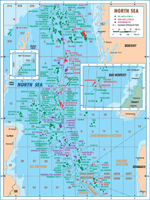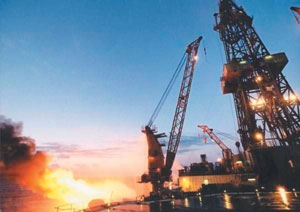Western Europe: Norway
Aug. 2001 Vol. 222 No. 8 International Outlook WESTERN EUROPE North Sea portions written by Arthur Andersen-Petroleum Services Group, London Norway
WESTERN EUROPENorth Sea portions written by Arthur Andersen-Petroleum Services Group, London NorwayLicensing. In May 2000, the Norwegian government announced that it had invited companies to nominate acreage they would like to see included in the "North Sea Awards 2000." Companies were invited to nominate up to 10 blocks, or combinations, that they would like to see included in the Round. By the nomination deadline of June 15, 2000, 15 companies had submitted proposals, which spanned acreage from the 62nd parallel to the Danish-Norwegian boundary line, with 34 blocks or part-blocks nominated by two or more companies. The Government announced the acreage offered, which totaled 40 blocks or part-blocks. Following the invitation of nominations and announcement of acreage offered, the Ministry of Petroleum and Energy awarded licenses in 15 blocks or part-blocks to 11 companies in the North Sea Awards 2000.
Conoco, Enterprise, Phillips, RWE-DEA and Statoil have been offered operatorship in the new license areas. A newcomer to the Norwegian Continental Shelf, Aker Maritime ASA has been awarded its first oil and gas production license. The long-awaited white paper detailing proposals for changes in the framework of the SDFI was expected in early 2000, but it was reported that grass-root members of the Norwegian Labor party had managed to block this. In the last quarter of 2000, the Norwegian Government announced plans to redistribute 21.5 % of the State’s Direct Financial Interest (SDFI) and effect a partial privatization of Statoil. Restructuring in the Norwegian oil and gas industry began in earnest at the end of April 2001, with parliamentary approval of the proposition on the ownership of Statoil and future management of the SDFI. In early May, 15% of the SDFI was initially sold to Statoil and, as a result, the company acquired additional interests in Troll, Gullfaks, Snorre, Vigdis, Tordis, Visund, Statfjord, Statfjord East, Aasgard, Sleipner East and Sleipner West fields. Total consideration of the deal was U.S. $4.24 billion. The outstanding 6.5% is to be sold to Norsk Hydro and foreign oil companies; the estimated value of the remaining share is $1.84 billion. Also in early May, Petoro was established to administer the remaining SDFI. In addition, the government set up an independent company, Gasco, to run the offshore Norwegian gas transportation system previously operated by Statoil. In June, Statoil made its stock market debut, with 17.5% of the company listing on Oslo and New York exchanges. Drilling. In Norway, a total of 33 new exploration wells were started between July 1, 2000 and June 30, 2001, with 26 of the spuds as wildcats, the remaining seven appraisals. Almost half (47%) of the wells were in the Norwegian Sea; 30% lie in the North Sea, with the remaining 23% drilled in the Barents Sea.
Exploration. During the 12-month period, a total of eight Norwegian discoveries were made. In the North Sea, two near-field accumulations were found. At the beginning of July 2000, Statoil completed Well 30/3-9, drilled on C-structure to the south of Huldra field. Gas and condensate were encountered in a Middle Jurassic Sandstone reservoir, but the well was not tested. At the beginning of 2001, Norsk Hydro discovered hydrocarbons in a Jurassic sand near Varg field, with 15/12-12. In the Norwegian Sea, Statoil found oil in the Early Jurassic Falk structure to the northeast of Norne field. At the end of 2000, ExxonMobil announced discovery of the Bella Donna accumulation, where 6506/6-1 found gas in the Early to Middle Jurassic with initial reserves estimates in excess of 3.5 Tcf. In January 2001, Conoco encountered oil with 6507/7-13, located just north of Heidrun. A geological sidetrack was drilled to further evaluate the find. Farther north, three new discoveries were made in the Barents Sea. In October 2000, Agip made the first oil discovery, Well 7122/7-1. The Goliath field is estimated to hold 115 MMbbl oil in a Jurassic reservoir. Agip then went on to make the Gamma discovery with 7019/1-1, which found gas in the Cretaceous and Jurassic. At the beginning of 2001, Statoil found oil / gas in the Triassic with sidetrack 7228/7-1 A.
Development / production. During 2000, development plans for five fields in the Norwegian part of the North Sea were approved. Combined estimated reserves for Fram, Grane, Kvitebjørn, Ringhorne and Vale are 1.43 Bbbl oil and 4.12 Tcf gas. Fram and Vale are expected to be developed as subsea tiebacks and Grane, Kvitebjørn and Ringhorne as platform developments. Ringhorne is expected to start production in 2001. Two fields began production in 2000, Oseberg South and Sigyn. Oil and gas production began from the Oseberg South platform development. Sigyn is a subsea tieback to Sleipner A platform, producing oil and gas. In 2000, Norwegian oil production reached 1.21 Bbbl, a small increase of 3% on the 1999 figure, giving a daily average output of 3.3 MMbopd. Gas production was also up on the previous year, reaching a total 1.77 Tcf, an increase of 3%. This was equivalent to a 4.8 Bcfpd average gas production. Gas sales contracts are negotiated by the Joint Negotiations Committee (GFU), under the leadership of Statoil, with representatives from Norsk Hydro. This committee advises in development / exploitation of gas fields to meet new gas sales commitments. The Norwegian Government has indicated recently that
the GFU will be disbanded. This is, in part, due to pressure from the European Union, as the GFU prevents
Norway from being compliant with the EU’s gas directive on liberalization of Europe’s gas markets.
The GFU will be temporarily abolished from June 1, 2001, then permanently from January 1, 2002.
|
|||||||||||||||||||||||||||||||||||||||||||||||||||||||||||||||||||||||||||||||||||||||||||||||||||||||||||||||||||||||||||||||||||||||||||||||||||||||||||||||||||




